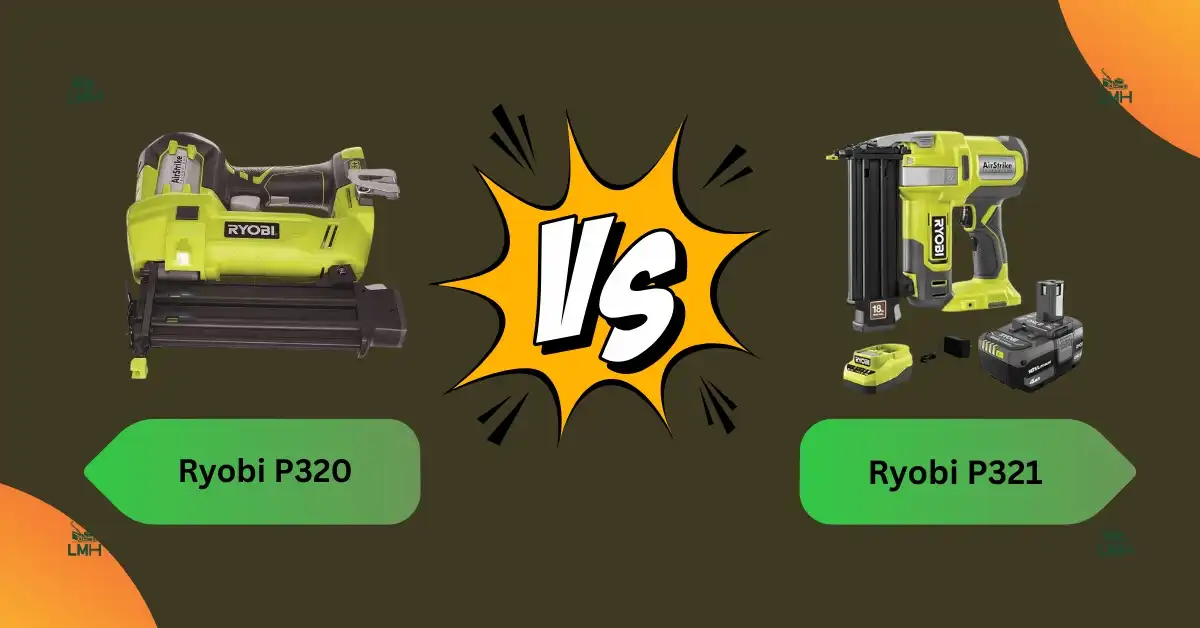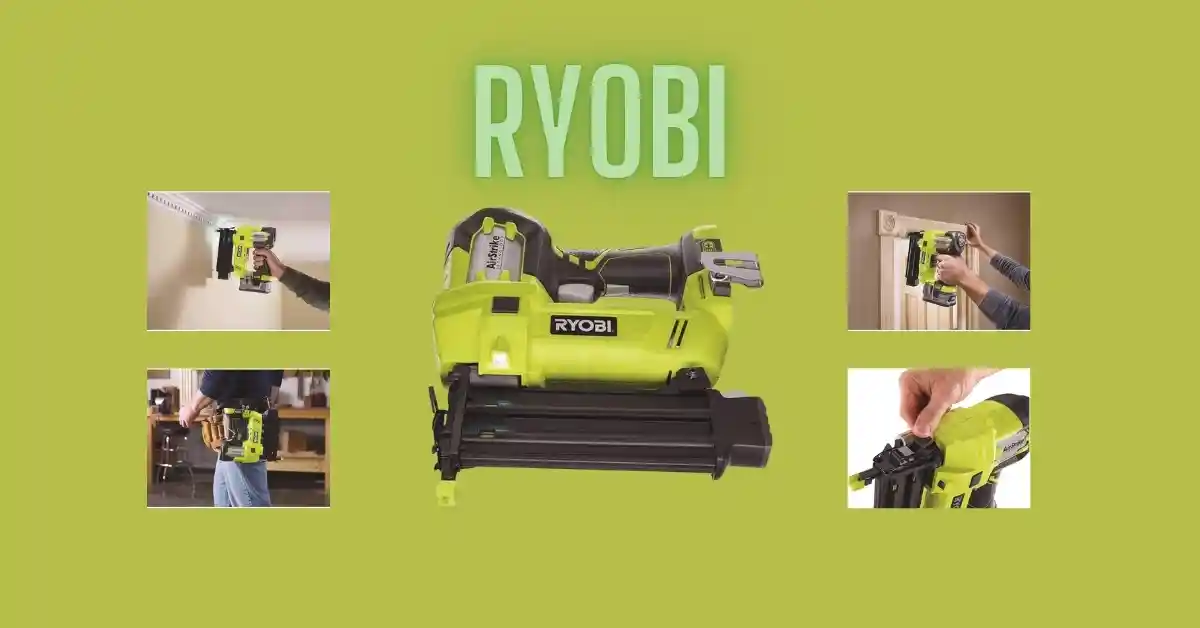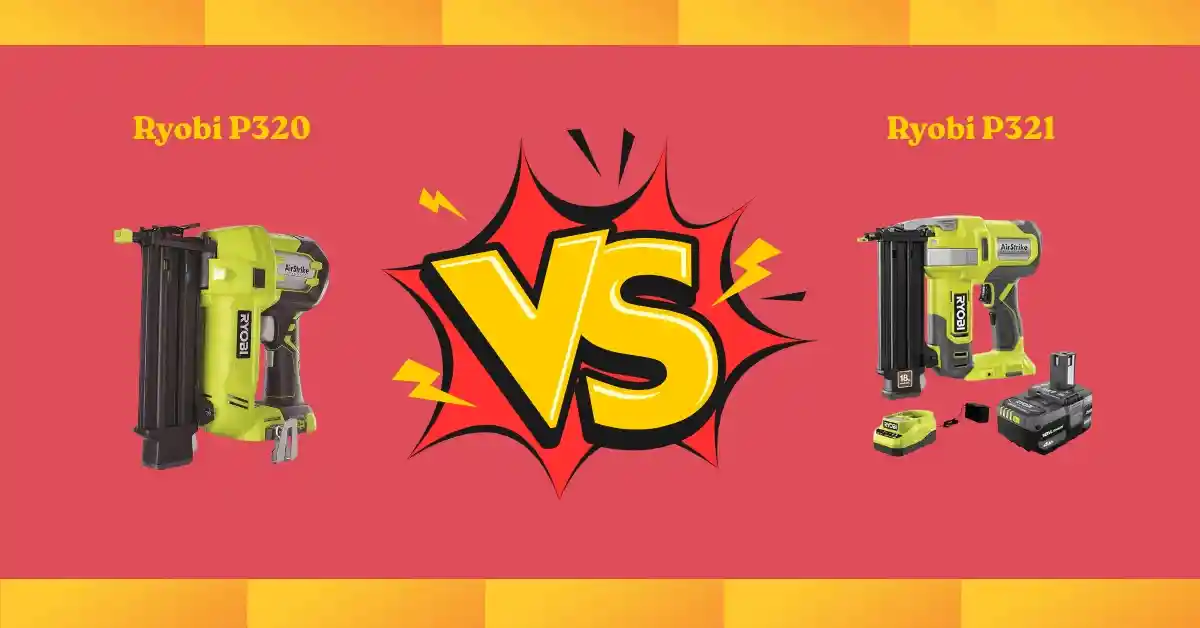Ryobi P320 vs P321 Key Insights for Peace of Mind
Looking at Ryobi P320 vs P321 can feel tricky when both promise cordless ease and reliable power. The direct answer is this: the P320 is a solid, budget-friendly option, while the P321 offers more control and refinements for detail work.
Based on research and user feedback, these tools stand out for DIY homeowners and light carpentry in the U.S. If you’re weighing which one to buy, here’s a clear, side-by-side breakdown to help you decide with confidence.

Ryobi P320
I explored many sources to learn about this tool and how it stands out. Users often share both the good and the not-so-good parts. My goal here is to share clear points so you know what to expect. This is based on common insights, not only one person’s view.
What is Special About This
The Ryobi P320 is special because it gives the freedom of cordless use with the strength of a classic nail gun. You do not need hoses, gas, or heavy gear. It is made to save time, cut down setup, and still give steady results.
- Cordless style removes the need for a compressor or gas cartridges.
- Can drive up to 1,700 nails on one charge, so there are fewer breaks.
- Depth and air pressure settings make it easy to work on both softwood and hardwood.
- LED light helps when working in dark or tight spots.
- Low-nail alert stops dry firing and saves both time and nails.
- Works with all Ryobi 18V ONE+ batteries, so it fits with other tools in the set.
- Strong enough for pros, yet simple enough for beginners to use.
What Could Be Better
No tool is without flaws, and this one is the same. The Ryobi P320 has small points that may be a challenge for some people.
- The tool feels heavy if used for long hours.
- May jam at times, more so with long nail strips.
- Battery does not come with it, which adds cost for new buyers.
- Bulkier than some new compact models.
How It Can Be Improved
- A lighter body or better weight balance could help comfort.
- A stronger nail chamber could cut down on jams.
- Starter packs with a battery would be easier for new users.
- A slim and light update, like the Ryobi P321, shows the way forward.
My Personal Experience
I checked many reviews, tests, and user notes to share a full and fair view. Below are points on design, performance, and build that many people talk about with this tool.
Design
The Ryobi P320 has a simple and smart design. The cordless build makes it easier than a nailer with a compressor. Its bright green color stands out, and the grip feels good in the hand. The LED lights are a smart touch, as they help in low light spots. The weight is more than some may want, but the design still gives a good mix of power and ease.
Performance
This tool is strong in use. It sinks nails well in softwood and hardwood. The depth adjust makes it easy to get the right finish. One charge gives up to 1,700 nails, which is more than most rivals in the same range. For trim, baseboards, and small builds, it gives a clean and steady job. Jams can happen, but they are easy to clear, so work goes on without much delay.
Build Quality
Ryobi is known for solid tools, and the P320 is no different. Many users say it lasts for years with few problems. The tough frame makes it fit for both home and light job work. It is a bit heavy, but the strong feeling adds trust. When stacked against high-cost brands, many still see this as the better deal.
ryobi p321
I explored different sources to understand this product better and share clear insights. Many reviews, expert notes, and user comments helped shape this overview. The goal is to explain what makes the Ryobi P321 useful, what could be better, and how it compares with other tools. This way, anyone can decide if it fits their needs with confidence.
What is Special About This
The Ryobi P321 stands out for many reasons. It is designed to make projects easier, faster, and more enjoyable. Many users notice features that improve comfort and results.
- AirStrike Technology removes the need for hoses, gas, or a loud compressor.
- Compact body compared to the P320, which makes it easier to hold and use.
- Smaller nose for better accuracy and cleaner finishes on trim and molding.
- Depth adjustment with no tools needed, so nails sit flat without harming the surface.
- Built-in LED light to see clearly in corners or dim workspaces.
- Quick nail loading and simple jam release system for less downtime.
- Strong battery life, letting you work longer without charging.
What Could Be Better
No tool is perfect. Some areas may feel less ideal for certain users. These are common points people bring up about the Ryobi P321:
- There can be nail jams or misfires, depending on the type of brad used.
- The weight feels heavy after long use since the battery adds bulk.
- It is great for DIY projects, but may not handle tough, all-day pro work.
- Bulk packaging can make it feel less polished when first opened.
How It Can Be Improved
- A lighter battery option would make long sessions easier.
- A smoother firing system could reduce jamming and misfires.
- A stronger pro-grade version could meet the needs of advanced users.
These small tweaks could make the P321 even better. Still, the tool already gives strong value for most people.
My Personal Experience
I have explored many sources to learn about this tool and share balanced insights. By looking at user reviews and expert opinions, it is easier to see how the Ryobi P321 holds up in design, performance, and build.
Design
The design of the Ryobi P321 is simple but smart. A slim nose makes it easier to place nails with care. The compact frame allows better control in tight spots. The LED light is another helpful touch. Many users also like the bright green body, which makes it easy to find in a crowded tool bag.
Performance
The P321 is known to work well for most home projects. It handles crown molding, baseboards, and paneling without issue. The depth adjustment and pressure dial make it easy to set nails at the right level. While some users mention jams, many say it works well with different brad sizes. For DIY jobs, the tool feels fast and reliable.
Build Quality
Ryobi tools are known for being tough and affordable, and the P321 fits that image. The ABS material gives it a sturdy frame. The cordless style adds freedom while working. It does feel heavy after long use, but most agree it balances weight with strength. Compared to the older P320, the P321 feels more refined and easier to handle.

Ryobi P320 vs P321: Detailed Comparison
People who tried both say the Ryobi P320 and P321 are great cordless brad nailers. They look the same at first, but they do not feel the same in real use. The P320 is the older tool. The P321 is the newer one. Both are built for trim, baseboards, and light wood jobs. Let’s look at how they compare point by point.
Design & Size: Ryobi P320 vs P321
The P320 is a bit bigger and feels bulky. The P321 is 12% smaller, which helps when you work in tight spots.
| Feature | Ryobi P320 | Ryobi P321 |
| Size | Larger, older design | 12% smaller, newer build |
| Best Use | General jobs | Trim and small spaces |
Rating
- P320: 8/10
- P321: 9/10
Weight & Portability: Ryobi P320 vs P321
The P320 weighs about 6 lbs without the battery. The P321 is about 8.3 lbs in the kit with the battery and charger. The P320 feels lighter, but both are fine for short work.
| Feature | Ryobi P320 | Ryobi P321 |
| Weight | 6 lbs (tool only) | 8.3 lbs (with kit) |
| Portability | Lighter | Slightly heavier |
Rating
- P320: 8.5/10
- P321: 8/10
Nose Size & Precision: Ryobi P320 vs P321
The P321 has a 45% smaller nose. This gives a clear view when placing nails. The P320 works fine, but the nose is bigger.
| Feature | Ryobi P320 | Ryobi P321 |
| Nose Size | Larger | 45% smaller |
| Precision | Good | Better |
Rating
- P320: 7.5/10
- P321: 9/10
Depth Adjustment & Air Pressure Control: Ryobi P320 vs P321
Both tools let you adjust depth and air pressure with no extra tool. This makes it easy to set nails right on soft or hard wood.
| Feature | Ryobi P320 | Ryobi P321 |
| Depth Adjustment | Yes | Yes |
| Air Pressure Dial | Yes | Yes |
Rating
- P320: 8.5/10
- P321: 8.5/10
Performance & Driving Power: Ryobi P320 vs P321
The P320 sinks nails deep and clean. It works even on hardwood. The P321 also drives well, but some people say it misfires more often.
| Feature | Ryobi P320 | Ryobi P321 |
| Driving Power | Strong, steady | Strong but mixed |
| Nail Length | 5/8″–2″ | 5/8″–2″ |
Rating
- P320: 8.5/10
- P321: 8/10
Battery Life & Efficiency: Ryobi P320 vs P321
With a big battery, the P320 can fire up to 1700 nails on one charge. The P321 is close, but the kit battery in some packs does not last as long.
| Feature | Ryobi P320 | Ryobi P321 |
| Battery Life | Up to 1700 nails | Good, varies with battery |
| Efficiency | Excellent | Good |
Rating
- P320: 9/10
- P321: 8.5/10
Jamming Issues & Reliability: Ryobi P320 vs P321
The P320 may jam when you use long nail strips. But jams are easy to clear. The P321 has mixed reviews. Some people say it never jams. Others say it jams a lot.
| Feature | Ryobi P320 | Ryobi P321 |
| Jamming | Sometimes with long strips | Mixed—some good, some bad |
| Reliability | Proven | Less proven |
Rating
- P320: 8/10
- P321: 7/10
Ease of Use & Handling: Ryobi P320 vs P321
Both tools are cordless, simple, and safe. They have LED lights and locks. The P321 is more compact but a little heavier. The P320 is bigger but balanced.
| Feature | Ryobi P320 | Ryobi P321 |
| Handling | Balanced but bulky | Compact nose, a bit heavier |
| User-Friendly | Yes | Yes |
Rating
- P320: 8/10
- P321: 8.5/10
Durability & Build Quality: Ryobi P320 vs P321
The P320 has been around longer. Many people say it lasts for years. The P321 is new. It feels solid but does not yet have the same track record.
| Feature | Ryobi P320 | Ryobi P321 |
| Build Quality | Proven | Solid but newer |
| Durability | Long record | Needs more time |
Rating
- P320: 8.5/10
- P321: 8/10
Price & Value for Money: Ryobi P320 vs P321
Both nailers cost less than top brands like DeWalt or Makita. The P320 is often sold tool-only, while the P321 comes in kits. Both give good value for home users.
| Feature | Ryobi P320 | Ryobi P321 |
| Price | Affordable tool-only | Affordable in kit |
| Value | Excellent | Good |
Rating
- P320: 9/10
- P321: 8.5/10
Customer Feedback & Overall Verdict: Ryobi P320 vs P321
Most people like the P320 for its steady work and long life. The P321 gets praise for better nose size and neat design. But reviews on jamming are mixed. Both are good for home jobs, but the P320 feels safer if you want something tested.
| Feature | Ryobi P320 | Ryobi P321 |
| Customer Reviews | Mostly good, proven | Mixed—great for some, poor for others |
| Overall Verdict | Reliable and trusted | Compact but not as steady |
Rating
- P320: 8.5/10
- P321: 8/10
Final Thoughts on Ryobi P320 vs P321
If you’re someone who values simple setup, cordless ease, and solid performance for trim or home projects, the Ryobi P320 vs P321 nailers are a smart pick. But if you want a lighter tool with zero misfires for daily pro use, you may need to explore higher-end brands. Think of the P320 as the old truck that always starts, while the P321 is the newer car with better features but a few quirks. Both get the job done—it just depends on what matters most to you.
FAQ on Ryobi P320 vs P321
- What is the main difference between Ryobi P320 vs P321?
The P320 is simpler and budget-friendly, while the P321 adds better depth control and precision. Learn more about which fits your needs. - Which is better for home DIY: Ryobi P320 or P321?
For quick home projects, the P320 is easy to use. The P321 is better if you want more accuracy and control. Learn more about their strengths. - Does Ryobi P321 have fewer jamming issues than P320?
Yes, many users say the P321 jams less and feels smoother. The P320 can jam more often on tough tasks. Learn more about user feedback. - How long does the battery last on Ryobi P320 vs P321?
Both run on Ryobi 18V batteries. The P321 is a bit more efficient, but real life use is similar. Learn more about battery performance. - Is Ryobi P321 worth the extra cost over P320?
The P321 costs a little more but gives better control and fewer jams. The P320 is cheaper and reliable. Learn more about value for money.
Read More: What’s Better for You? OP40601 vs OP40602 Detailed Guide

